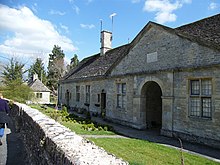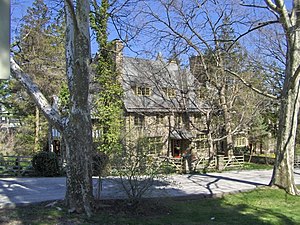29:
107:. These influences led to changes in the exteriors as well as interiors of Cotswold-style buildings. Classical influences to the exteriors included the use of stucco on walls, which often replaced the limewash on original buildings. The interiors also changed, as Cotswold-style buildings came to have higher and wider lights and “loftier” rooms. The architecture also changed during the Arts and Crafts Movement. Smaller buildings were built with a mix of concrete block and stonework or roughcast brick and stonework. This allowed architects to save on costs due to stone being expensive during the Arts and Crafts movement.
148:. Since lead was not available, slate was used in its place. Henry Ford is noted to have appreciated the "distinctive architectural style and attractive weathered appearance of typical Cotswold buildings," whose stone elements "all blended together unbroken by other visible construction materials." Due to the steepness of the roofs, most original Cotswold cottages had dormer windows and were not waterproof. Occasionally, lead was employed in gutter systems around the roof. As a result of the roof angles, roofs made with pseudo-
125:
155:
Like the roofs, the walls of
Cotswold residences were susceptible to the elements. Though the walls were thick, they were hollow and filled with rocks and "rubbish" and were not reinforced with any binding materials. The stone slates were naturally thick. The walls had to compensate by being thicker
175:
The rooms of residence constructed in the
Cotswold style are often small and irregularly shaped. The floorplan of a Cotswold cottage is generally bisected by a staircase, and the bedrooms are on the first floor. These staircases, along with the internal walls, are made of wood. Traditionally, oak,
99:
The
Cotswold style of architecture is characterized by simplicity. The Cotswold buildings were built to 'melt into their surroundings'. The original Cotswold cottages were built for rural laborers, including farmers who reared sheep. Additionally, the rural location of the Cotswold region limited
79:
The
Cotswold style emerged during the late 16th century and flourished throughout the 17th century. During the second and third decades of the twentieth century, the Cotswold style reached its zenith of popularity. The Cotswold 'Arts and Crafts' architecture was a very popular and prominent style
115:
The features of the
Cotswold style are primarily identifiable through the use of specific materials. In the Cotswold region, oolite limestone and hard wood are abundant. Lead, on the other hand, was scarce during throughout the 17th and 18th centuries, so it is not utilized in any traditional
116:
buildings of the
Cotswold style. One use of limestone in the Cotswold region was called limestone walling. This technique gives a range of color to the Cotswold style due to the amount of iron oxide in the limestone layer. The limestone was also used as slates for the Cotswold roofing.
171:
Buildings of the
Cotswold style typically have one or two large fireplaces, depending on the size and function of the building. The fireplaces both release into a chimney. The interiors of the chimneys as well as the mantles are made of stone.
406:
Old
Cottages, Farm-houses, and Other Stone Buildings in the Cotswold District: Examples of Minor Domestic Architecture in Gloucestershire, Oxfordshire, Northants, Worcestershire, &c
298:
361:
76:
and steep roofs. The
Cotswold style uses local materials based on geology. This style is renowned for the use of local oolitic limestone.
129:
448:
501:
627:
511:
484:
332:
295:
724:
423:
474:
404:
91:
house style, and it likely came to the United States as a result of renewed interest in medieval housing styles.
754:
100:
access to building materials. This style used local materials to create the distinctive look of the
Cotswolds.
28:
529:"A revised lithostratigraphy for the Inferior Oolite Group (Middle Jurassic) of the Cotswolds, England"
133:
528:
261:
200:
449:"The Arts and Crafts Movement in the Cotswolds – The Wilson – Cheltenham Art Gallery & Museum"
159:
The king mullion is a common element of the Cotswold style. The windows of Cotswold cottages were
104:
195:
137:
156:
than the slates in Cotswold traditional houses in order for the building to be supported.
8:
152:, steep arch gables, and arched doorways are all common features of the Cotswold style.
695:
283:
544:
730:
720:
687:
623:
570:
548:
507:
480:
241:
163:. In smaller structures, the windows were the only elements in which lead was used.
699:
677:
615:
540:
229:
215:
571:"Gloucestershire Across the Atlantic: The Story of a Traveling Cottage and Smithy"
607:
302:
278:
224:
220:
81:
619:
84:
in the Cotswolds became the focal point of the 'Arts and Crafts' architecture.
265:
248:
72:, often near the front door of the house. Other notable features include king
748:
691:
552:
88:
734:
205:
210:
714:
682:
665:
160:
333:"The Architecture of the Cotsmolds in the 16th & 17th Centuries"
144:
The leading feature of Cotswold architecture is the grouping of the
176:
chestnut, and beech, all native to the Cotswold region, were used.
61:
527:
Barron, A. J. M.; Sumbler, M. G.; Morigi, A. N. (1 January 1997).
73:
69:
65:
128:
Cotswold-style house at 300-04 West Willow Grove Avenue, in the
190:
149:
362:"Traditional Cotswold Materials and Contemporary House Design"
124:
145:
424:"The History Press | Cotswold Arts and Crafts architecture"
578:
Gloucestershire Society for Industrial Archaeology Journal
595:. Manchester: Manchester University Press. p. 259.
593:
Traditional Domestic Architecture of the Banbury Region
103:
The Cotswold style later came to be influenced by the
526:
614:, London: Palgrave Macmillan UK, pp. 91–137,
746:
268:, the preparatory school attended by the author.
712:
473:Jordan, Tim; Walrond, Lionel (15 April 2014).
472:
648:
666:"A Record of the Changing Face of Britain"
590:
533:Proceedings of the Geologists' Association
87:Cotswold architecture is a subtype of the
27:
719:. New York: Delacorte Press/S. Lawrence.
681:
68:. Cotswold houses often have a prominent
330:
123:
663:
605:
568:
235:
747:
499:
402:
110:
612:Perspectives in English Urban History
503:Cotswold Arts and Crafts Architecture
500:Gordon, Catherine (24 January 2020).
80:between 1890 and 1930. The county of
50:Classical architecture, Tudor Revival
564:
562:
418:
416:
398:
396:
394:
392:
390:
388:
386:
384:
382:
356:
354:
352:
350:
326:
324:
322:
320:
318:
60:is a style based on houses from the
13:
33:Cotswold Cottage, Coln St. Aldwyns
14:
766:
608:"The English Urban Inn 1560–1760"
559:
413:
379:
347:
315:
289:
664:Cornish, Vaughan (1 July 1941).
254:
706:
657:
642:
599:
591:Wood-Jones, Raymond B. (1963).
584:
479:. Amberley Publishing Limited.
260:Dorset Academy, the setting of
105:Classical style of architecture
520:
493:
466:
441:
331:Marsland, Ellis (March 1906).
58:Cotswold style of architecture
1:
649:Baring-Gould, Sabine (1892).
545:10.1016/S0016-7878(97)80012-0
308:
264:' A Good School and based on
184:
94:
716:A good school : a novel
166:
119:
7:
620:10.1007/978-1-349-00575-8_5
453:www.cheltenhammuseum.org.uk
403:Dawber, Edward Guy (1905).
272:
179:
138:Duhring, Okie & Ziegler
10:
771:
343:: 88 – via ProQuest.
134:Philadelphia, Pennsylvania
16:Architectural design style
428:www.thehistorypress.co.uk
46:
38:
26:
201:Broadway, Worcestershire
713:Yates, Richard (1978).
606:Everitt, Alan (1973),
569:Stening, Theo (2010).
301:9 October 2006 at the
141:
42:England, United States
755:Cotswold architecture
506:. The History Press.
266:Avon Old Farms School
127:
22:Cotswold Architecture
337:Architect's Magazine
236:In the United States
196:Bourton-on-the-Water
111:Structural elements
23:
653:. London: Metheun.
476:The Cotswold House
296:About architecture
284:Tudor architecture
142:
21:
629:978-1-349-00577-2
513:978-0-7509-9442-2
486:978-1-4456-3722-8
409:. B. T. Batsford.
242:Rufus Arndt House
54:
53:
762:
739:
738:
710:
704:
703:
685:
683:10.1038/148104a0
661:
655:
654:
651:Old Country Life
646:
640:
639:
638:
636:
603:
597:
596:
588:
582:
581:
575:
566:
557:
556:
524:
518:
517:
497:
491:
490:
470:
464:
463:
461:
459:
445:
439:
438:
436:
434:
420:
411:
410:
400:
377:
376:
374:
372:
358:
345:
344:
328:
247:Rose Cottage at
230:Stow-on-the-Wold
216:Coln St. Aldwyns
161:glazed with lead
31:
24:
20:
770:
769:
765:
764:
763:
761:
760:
759:
745:
744:
743:
742:
727:
711:
707:
662:
658:
647:
643:
634:
632:
630:
604:
600:
589:
585:
573:
567:
560:
525:
521:
514:
498:
494:
487:
471:
467:
457:
455:
447:
446:
442:
432:
430:
422:
421:
414:
401:
380:
370:
368:
360:
359:
348:
329:
316:
311:
303:Wayback Machine
292:
279:Storybook house
275:
257:
238:
225:Lower Slaughter
221:Upper Slaughter
187:
182:
169:
122:
113:
97:
82:Gloucestershire
34:
17:
12:
11:
5:
768:
758:
757:
741:
740:
725:
705:
656:
641:
628:
598:
583:
558:
539:(4): 269–285.
519:
512:
492:
485:
465:
440:
412:
378:
346:
313:
312:
310:
307:
306:
305:
291:
290:External links
288:
287:
286:
281:
274:
271:
270:
269:
256:
253:
252:
251:
249:the Henry Ford
245:
237:
234:
233:
232:
227:
218:
213:
208:
203:
198:
193:
186:
183:
181:
178:
168:
165:
121:
118:
112:
109:
96:
93:
52:
51:
48:
44:
43:
40:
36:
35:
32:
15:
9:
6:
4:
3:
2:
767:
756:
753:
752:
750:
736:
732:
728:
726:0-440-03246-6
722:
718:
717:
709:
701:
697:
693:
689:
684:
679:
676:(3743): 104.
675:
671:
667:
660:
652:
645:
631:
625:
621:
617:
613:
609:
602:
594:
587:
579:
572:
565:
563:
554:
550:
546:
542:
538:
534:
530:
523:
515:
509:
505:
504:
496:
488:
482:
478:
477:
469:
454:
450:
444:
429:
425:
419:
417:
408:
407:
399:
397:
395:
393:
391:
389:
387:
385:
383:
367:
363:
357:
355:
353:
351:
342:
338:
334:
327:
325:
323:
321:
319:
314:
304:
300:
297:
294:
293:
285:
282:
280:
277:
276:
267:
263:
262:Richard Yates
259:
258:
255:In literature
250:
246:
243:
240:
239:
231:
228:
226:
222:
219:
217:
214:
212:
209:
207:
204:
202:
199:
197:
194:
192:
189:
188:
177:
173:
164:
162:
157:
153:
151:
147:
140:, architects.
139:
135:
131:
130:Chestnut Hill
126:
117:
108:
106:
101:
92:
90:
89:Tudor Revival
85:
83:
77:
75:
71:
67:
63:
59:
49:
45:
41:
37:
30:
25:
19:
715:
708:
673:
669:
659:
650:
644:
633:, retrieved
611:
601:
592:
586:
577:
536:
532:
522:
502:
495:
475:
468:
456:. Retrieved
452:
443:
431:. Retrieved
427:
405:
369:. Retrieved
366:HollandGreen
365:
340:
336:
206:Castle Combe
174:
170:
158:
154:
143:
114:
102:
98:
86:
78:
57:
55:
18:
244:, Wisconsin
211:Cirencester
132:section of
635:12 October
458:4 December
433:4 December
371:4 December
309:References
185:In England
95:Influences
64:region of
47:Influences
692:1476-4687
553:0016-7878
167:Interiors
120:Exteriors
749:Category
580:: 39–42.
299:Archived
273:See also
180:Examples
136:(1913),
74:mullions
62:Cotswold
39:Location
735:3965867
700:4092769
70:chimney
66:England
733:
723:
698:
690:
670:Nature
626:
551:
510:
483:
191:Bibury
150:thatch
146:gables
696:S2CID
574:(PDF)
731:OCLC
721:ISBN
688:ISSN
637:2020
624:ISBN
549:ISSN
508:ISBN
481:ISBN
460:2023
435:2023
373:2023
223:and
56:The
678:doi
674:148
616:doi
541:doi
537:108
751::
729:.
694:.
686:.
672:.
668:.
622:,
610:,
576:.
561:^
547:.
535:.
531:.
451:.
426:.
415:^
381:^
364:.
349:^
339:.
335:.
317:^
737:.
702:.
680::
618::
555:.
543::
516:.
489:.
462:.
437:.
375:.
341:6
Text is available under the Creative Commons Attribution-ShareAlike License. Additional terms may apply.

